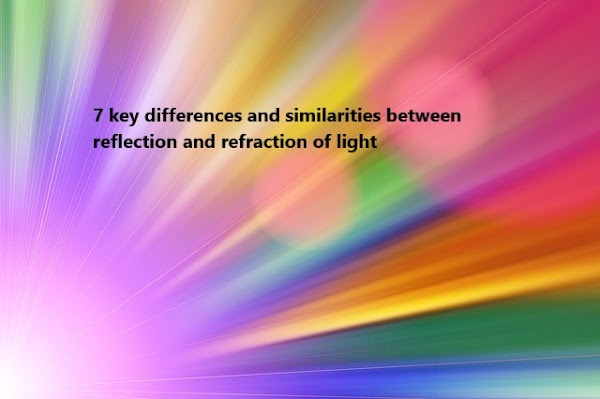7 key differences and similarities between reflection and refraction of light
Reflection and refraction both are the concept holder of optics. In optics both have a different laws. i.e, Laws of reflection and laws of refraction. Basically these laws are the back bone of optics or light. 50% of the syllabus of optics hold by these two laws. So before we procced to find the differences and similarities between reflection and refraction of light. We should have to know a little about reflection and refraction.
Concept of Reflection in optics
In simple word, reflection is the bouncing back of light. That means, In reflection of light, light waves get reflect when falls on a surface. weather it is smooth or rough. For smooth surface it follows the law of reflection of light but for rough surface it gets diffuse and don't follow the law of reflection of light.
Law of reflection of light:-
- Incident ray, the reflected ray, Normal and the point of incident where incident ray touches the surface, all lies on the same plane lines.
- When a beam of light falls on a smooth surface obliquely, it gets reflect in the same direction with making an equal angle to the normal lines. i.e, Incident ray makes angle ∠i with the normal whereas reflected ray makes angle ∠r with the normal. And both the angles ∠i and ∠r becomes equal to each other.
Hence, In law of reflection of light ∠i = ∠r. Please note that reflection of light occurs only when light travels in one medium.
Refraction of light:-
In simple word, refraction of light is the bending of light, when travelling from one medium to another medium. That means, when a beam of light passing through another medium (which have different refractive index to the compare of first medium) then, it gets bend at the edge of the second medium.
Refraction of light also have two laws.
- An incident ray, the refracted ray, the point of incidence and Normal all lies on the same plane.
- When a beam of light falls obliquely on a second medium, it gets bend through the edge of that medium. Because, when light strikes at the edge their velocity get changes due to this it get refract in another direction. So thats the reason where sine angle of incidence to the sine angle of refraction always be constant.
Hence, the law of refraction has sine ∠i to the sine angle ∠r is constant. or sine ∠i / sine ∠r = constant.
Here following are the 7 key differences and similarities between reflection and refraction of light. All the given differences and similarities are explained in detail. In further part of this post.
7 key differences and similarities between reflection and refraction of light
(1.) Reflection is the bouncing back of light when falls on a smooth surface(or any other surface). On the other hand refraction is the banding of light when falls on the surface of the medium.
(2.) Reflection of light takes place in only one medium but refraction of light takes place in two different medium.
(3.) During the reflection, speed of light remains same but during refraction speed of light changes (increases or decreases).
(4.) In reflection of light the angle of incidence is equal to the angle of refraction. While In refraction of light the angle of incidence is not equal to the angle of refraction.
(5.) In reflection of light, the incidence ray, the reflected ray, the normal and the point of incidence lies on the same plane. Similarly In refraction of light, the incidence ray, the refracted ray, the normal and the point of incidence lies on the same plane.
(6.) In reflection of light the one sided of the medium must be polished. But In refraction both the side of the medium must be transparent.
(7.) In reflection there are total two laws. Similarly, In refraction there are also two laws.

